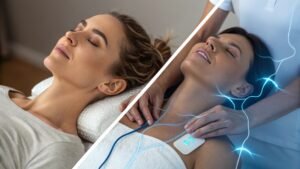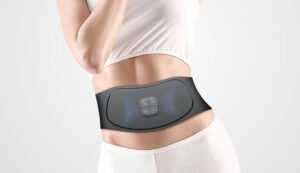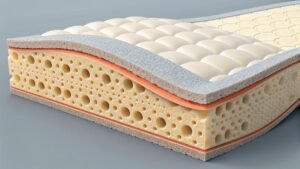Trouble falling asleep, staying asleep, or waking up refreshed? You’re not alone. As more people turn to wellness tech, EMS pulse stimulation is emerging as a surprising tool for sleep. But does it really work?
Yes, EMS pulse stimulation may help improve sleep by relaxing muscles, enhancing circulation, and calming the nervous system, but there’s limited clinical evidence specific to sleep outcomes.
While EMS devices are traditionally used for recovery and pain relief, a growing number of users are experimenting with them before bed. Let's explore if this tech trend is just hype—or if it’s a hidden gem in the sleep toolbox.
What is EMS pulse stimulation, and why is it linked to better sleep?
EMS, or Electrical Muscle Stimulation, has long been used in sports recovery. Now, it’s crossing into sleep wellness. Why?
EMS sends gentle electrical pulses to muscles, which may promote relaxation, reduce tension, and shift the body into rest mode—helpful ingredients for better sleep.
EMS doesn’t directly sedate you like melatonin or sleeping pills. Instead, it creates a relaxed body state, which may help quiet the mind too. That’s where the sleep connection begins.
Can muscle stimulation affect sleep quality?
You’ve probably noticed how hard it is to sleep when your body is tense or sore. EMS could be a solution to that.
Yes, EMS-induced muscle relaxation and endorphin release may support falling asleep faster and improving sleep depth.
Muscle relaxation and tension release
EMS pulses1 stimulate small muscle contractions. When done at low intensity, this may help:
- Loosen tight areas like the back or shoulders
- Reduce the physical symptoms of stress
- Create a body state similar to post-massage calmness
Endorphin effects
Muscle contractions also release endorphins2, which naturally reduce pain and promote well-being. Some users report feeling more “settled” after using EMS.
What do studies say about EMS and sleep?
Scientific curiosity around EMS for sleep is growing, but what does the research show?
Current studies are limited, but small trials and user reports3 suggest EMS may help with relaxation, which could indirectly benefit sleep.
Clinical research is still in early stages
Most EMS studies focus on:
- Muscle recovery
- Pain management
- Rehabilitation
But a few early papers suggest EMS can reduce anxiety and physical tension, especially in those with chronic conditions. These are closely related to sleep struggles.
Anecdotal support
Some EMS users—especially athletes and chronic pain patients—claim they fall asleep more easily after sessions. But without larger, sleep-focused studies, these findings remain observational.
How might EMS support better sleep?
So what makes EMS worth trying for sleep? Let’s break down the possible benefits.
EMS may promote muscle relaxation, improve blood flow, and help the nervous system shift into “rest mode”4—all of which are essential for falling asleep.
Promoting physical relaxation and reduced tension
One of the main ways EMS may help is by calming the body. Here’s how:
- Reduces muscle soreness or tightness from stress or workouts
- Makes the body feel “heavier,” similar to how massage or hot baths do
- Decreases physical fidgeting, a common barrier to sleep
Enhancing circulation and calming the nervous system
EMS may also encourage circulation, which has other relaxation benefits.
Benefits of increased blood flow
| Effect | Sleep Impact |
|---|---|
| Warmer limbs | May help with faster sleep onset |
| Less swelling | Increases comfort in bed |
| Oxygen delivery | Supports deeper physical rest |
EMS also activates the parasympathetic nervous system5—your body’s “rest and digest” mode. That’s crucial for winding down at night.
What are the risks or limits of using EMS for sleep?
It’s not all upside. EMS is not a one-size-fits-all solution.
People with certain medical conditions6 should avoid EMS, and there’s still no conclusive research that proves EMS can directly improve sleep.
Safety concerns and who should avoid EMS
Avoid EMS before bed if you:
- Have a pacemaker or other electrical implants
- Are pregnant (without doctor approval)
- Experience seizures
- Have unhealed wounds where pads are applied
Also, don’t fall asleep with the EMS device on—it’s not designed for overnight use.
Research gaps to be aware of
EMS isn’t a proven sleep aid. The relaxation effects may help, but:
- Results vary by person
- Placebo effect may play a role
- No long-term studies exist yet for sleep-specific outcomes
How can I use EMS effectively before bedtime?
Trying EMS for better sleep? A few best practices can help you avoid disappointment.
Use EMS about 30 minutes before bedtime on low intensity for 10–20 minutes. Avoid high-intensity or recovery-focused modes.
Best timing and settings for night use
| Time of Use | Ideal EMS Mode | Duration |
|---|---|---|
| 30–60 min before sleep | Relaxation / Massage | 10–20 minutes |
Avoid using EMS right before bed if it leaves you too alert or energized.
Choosing a sleep-friendly EMS device
Look for these features:
- Low-intensity massage modes
- Timer functions (auto shut-off)
- Certifications like FDA/CE for safety
- Trusted brand with user support
Avoid bulky gym-style EMS units—they’re too intense for bedtime.
Conclusion
EMS can help your body relax, which might support better sleep—but it’s not a guaranteed fix. Try it mindfully, and always consider personal health conditions.
FAQs
Can EMS replace melatonin or meditation?
No. EMS supports physical relaxation, while melatonin and meditation work on different systems.
Is EMS addictive?
Not chemically, but you might start relying on the routine. That’s not necessarily bad if it helps you unwind.
Can I use EMS every night?
Yes, but always listen to your body. Use low settings, and take breaks if you notice skin irritation.
Where should I place EMS pads for sleep?
Try shoulders, lower back, or calves—areas that often hold tension.
What if EMS wakes me up instead?
That can happen. Switch to shorter sessions earlier in the evening or try a different mode.
Footnotes
-
Learn how electrical muscle stimulation (EMS) can mimic post-massage relaxation and alleviate tension, a common barrier to quality sleep. ↩
-
Understand the science behind endorphin release through EMS and how it contributes to emotional calmness before sleep. ↩
-
Explore peer-reviewed studies examining whether EMS helps with relaxation, anxiety reduction, and sleep quality. ↩
-
Discover how EMS may shift your nervous system into a restful state, helping you fall asleep faster. ↩
-
EMS stimulation may promote parasympathetic activity, helping transition your body into a recovery and rest mode before sleep. ↩
-
Learn the safety guidelines and health risks of EMS—crucial if you have medical conditions or use implants. ↩





